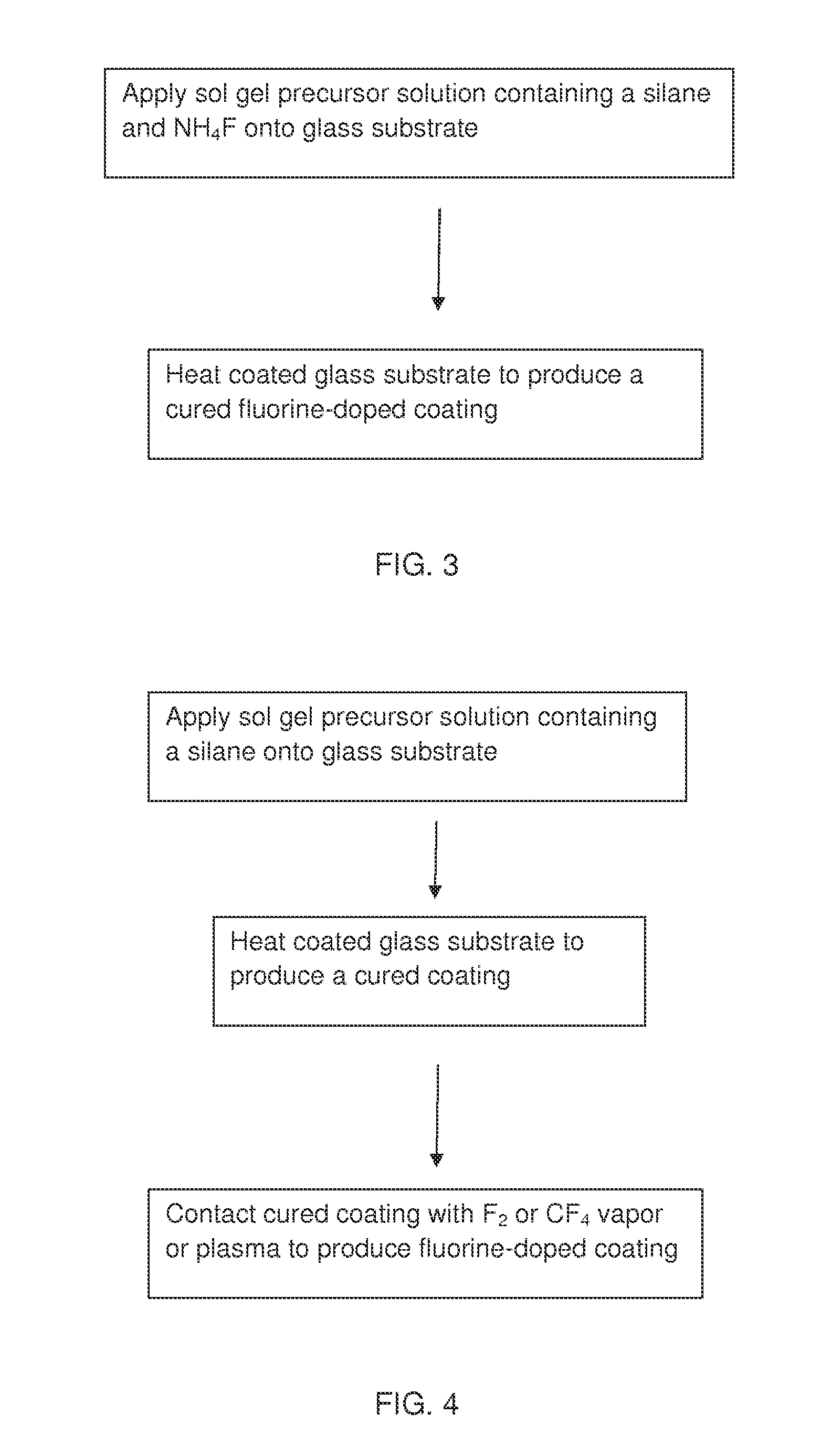Antireflection coatings
a technology of anti-reflection coating and anti-uv, which is applied in the direction of optical elements, instruments, transportation and packaging, etc., can solve the problems of increasing reflectivity, affecting the ability of the coating to act as an anti-reflection coating, and prone to degradation of anti-reflection coatings, so as to improve the durability, reduce the refractive index, and improve the effect of durability
- Summary
- Abstract
- Description
- Claims
- Application Information
AI Technical Summary
Benefits of technology
Problems solved by technology
Method used
Image
Examples
example 1
Fluorine-Doped Silica Particle-Binder Xerogel Precursor Using FSi(OC2H5 as a Fluorine Source
[0088]A solution precursor suitable for curtain, dip, meniscus, roll or spin coating is prepared. The solution precursor comprises (by volume at 20° C.) 0.1-10 parts triethoxyfluorosilane (TEFS, FSi(OC2H5)3), 0-10 parts tetraethoxysilane (TEOS, Si(OC2H5)4), 1-20 parts IPA-ST-UP silica nanoparticles (15% by weight in IPA), 0-5 parts glacial acetic acid, 0-5 parts deionized water and 0-100 parts n-propanol (NPA, C3H7OH). The mixture is homogenized at 20-30° C. for 0.01 to 24 hours, and then diluted with NPA to the desired final concentration for coating. Fluorine is incorporated into the coating through hydrolysis and condensation of TEFS with itself and with TEOS and IPA-ST-UP.
example 2
Fluorine-Doped Silica Xerogel Precursor Using FSi(OC2H5)3 as a Fluorine Source
[0089]A solution precursor suitable for curtain, dip, meniscus, roll or spin coating is prepared. The solution precursor comprises (by volume at 20° C.) 1-20 parts triethoxyfluorosilane (TEFS, FSi(OC2H5)3), 0-20 parts tetraethoxysilane (TEOS, Si(OC2H5)4), 0-5 parts glacial acetic acid, 0-10 parts deionized water and 0-100 parts n-propanol (NPA, C3H7OH). The mixture is homogenized at 20-30° C. for 0.01 to 24 hours, and then diluted with NPA to the desired final concentration for coating. Fluorine is incorporated into the coating through hydrolysis and condensation of TEFS with itself and with TEOS.
example 3
Fluorine-Doped Silica Particle-Binder Xerogel Precursor Using TFA as a Fluorine Source and Catalyst
[0090]A solution precursor suitable for curtain, dip, meniscus, roll or spin coating is prepared. The solution precursor comprises (by volume at 20° C.) 0-10 parts tetraethoxysilane (TEOS, Si(OC2H5)4), 1-20 parts IPA-ST-UP silica nanoparticles (15% by weight in IPA), 0.0001-5 parts anhydrous trifluoroacetic acid (TFA, CF3COOH), 0-10 parts deionized water and 0-100 parts n-propanol (NPA, C3H7OH). The mixture is homogenized at 20-30° C. for 0.01 to 24 hours, and then diluted with NPA to the desired final concentration for coating. Fluorine is incorporated into the coating during heat treatment of the coating, thermally decomposing the TFA into a variety of fluorine containing reactive gases that react with Si—OH groups, CO2, CO and H2O vapor.
PUM
| Property | Measurement | Unit |
|---|---|---|
| sliding angles | aaaaa | aaaaa |
| sliding angles | aaaaa | aaaaa |
| size | aaaaa | aaaaa |
Abstract
Description
Claims
Application Information
 Login to View More
Login to View More - R&D
- Intellectual Property
- Life Sciences
- Materials
- Tech Scout
- Unparalleled Data Quality
- Higher Quality Content
- 60% Fewer Hallucinations
Browse by: Latest US Patents, China's latest patents, Technical Efficacy Thesaurus, Application Domain, Technology Topic, Popular Technical Reports.
© 2025 PatSnap. All rights reserved.Legal|Privacy policy|Modern Slavery Act Transparency Statement|Sitemap|About US| Contact US: help@patsnap.com



